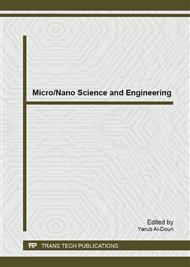[1]
R. R. Tummala, SOP: what is it and why? A new microsystem-integration technology paradigm-Moore's law for system integration of miniaturized convergent systems of the next decade, Advanced Packaging, IEEE Transactions on, vol. 27, pp.241-249, (2004).
DOI: 10.1109/tadvp.2004.830354
Google Scholar
[2]
S. E. Thompson and S. Parthasarathy, Moore's law: the future of Si microelectronics, Materials Today, vol. 9, pp.20-25, (2006).
Google Scholar
[3]
C. S. Zhang, et al., A thermal-mechanical coupled finite element model with experimental temperature verification for vertically stacked FPGAs, Microelectronic Engineering, (2011).
DOI: 10.1016/j.mee.2011.11.011
Google Scholar
[4]
E. C. Yeh, et al., Current-crowding-induced electromigration failure in flip chip solder joints, Applied physics letters, vol. 80, pp.580-582, (2002).
DOI: 10.1063/1.1432443
Google Scholar
[5]
H. Lin, Advanced ceramic heaters: Improving IC packaging and system performance, Advanced Packaging, vol. 16, pp.22-26, (2007).
Google Scholar
[6]
C. M. Chan, et al., Development of novel immersion gold for Electroless Nickel Immersion Gold process (ENIG) in PCB applications, (2010).
DOI: 10.1109/impact.2010.5699468
Google Scholar
[7]
K. H. Lee, Identification and prevention of" Black Pad" in Sn/Pb soldering, Circuit World, vol. 37, pp.10-15, (2011).
DOI: 10.1108/03056121111155620
Google Scholar
[8]
S. A. Belyakov and C. M. Gourlay, NiSn4 formation in As-soldered Ni-Sn and ENIG-Sn couples, Journal of Electronic Materials, vol. 41, pp.3331-3341, (2012).
DOI: 10.1007/s11664-012-2277-1
Google Scholar
[9]
W. Lai, et al., Development of novel electroless nickel for Selective electroless nickel immersion gold applications, 2012, pp.80-85.
DOI: 10.1109/impact.2012.6420219
Google Scholar
[10]
I. S. Aisha and A. Ourdjini, Effect of multiple reflow on IMC formation using various surface finishes, International Journal of Microstructure and Materials Properties, vol. 7, pp.502-516, (2012).
DOI: 10.1504/ijmmp.2012.051230
Google Scholar
[11]
J. W. Kim, et al., Transmission property of flip chip package with adhesive interconnection for RF applications, Microelectronic Engineering, vol. 86, pp.314-320, (2009).
DOI: 10.1016/j.mee.2008.10.012
Google Scholar
[12]
C. Wu, et al., The effects of bump height on the reliability of ACF in flip-chip, Soldering & surface mount technology, vol. 13, pp.25-30, (2001).
DOI: 10.1108/09540910110361686
Google Scholar
[13]
M.K. Md. Arshad, et al., The effects of multiple zincation process on aluminum bond pad surface for electroless nickel immersion gold deposition, Transactions of the ASME, (2006).
DOI: 10.1115/1.2229223
Google Scholar
[14]
A. Ostmann, et al., The pretreatment of aluminum bond pads for electroless nickel bumping, in Multi-Chip Module Conference, 1993. MCMC-93, Proceedings., 1993 IEEE, 1993, pp.74-78.
DOI: 10.1109/mcmc.1993.302148
Google Scholar
[15]
Z. Sauli, et al., Stress Analysis on Through Holes in PCB, in Computational Intelligence, Modelling and Simulation (CIMSiM), 2012 Fourth International Conference on, 2012, pp.144-147.
DOI: 10.1109/cimsim.2012.82
Google Scholar
[16]
Z. Sauli, et al., Polymer Core BGA Stress Analysis at Minimal Vertical Loading, Advanced Materials Research, vol. 622, pp.639-642, (2013).
DOI: 10.4028/www.scientific.net/amr.622-623.639
Google Scholar
[17]
V. Retnasamy, et al., Gold Ball Shear Stress Analysis on Different Surface Morphology, in Computational Intelligence, Modelling and Simulation (CIMSiM), 2012 Fourth International Conference on, 2012, pp.168-171.
DOI: 10.1109/cimsim.2012.88
Google Scholar
[18]
J. Antony, Improving the wire bonding process quality using statistically designed experiments, Microelectronics Journal, vol. 30, pp.161-168, (1999).
DOI: 10.1016/s0026-2692(98)00104-9
Google Scholar


